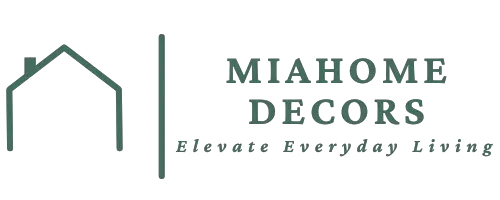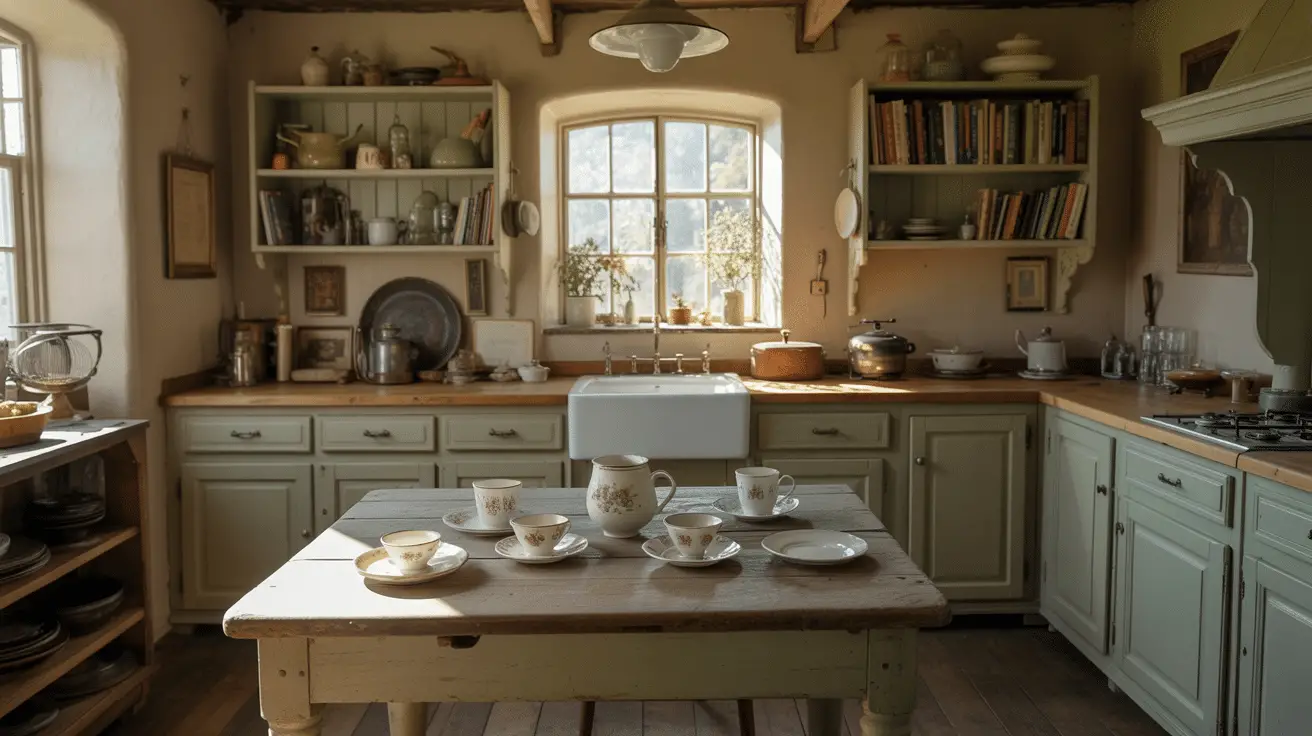Charming Unfitted Kitchen Ideas for Cozy Cottage Homes
Table of Contents
The Cozy Magic of an Unfitted Kitchen in a Cottage Home
Step inside a true country cottage, and chances are you won’t find rows of identical cabinets or glossy, factory-finished appliances. Instead, you’ll discover a more relaxed, lived-in charm—warm wooden counters, mismatched furniture, freestanding cupboards, and timeworn treasures. This is the beauty of the unfitted kitchen, a design approach that blends practicality with personality.
Unlike modern, fully-fitted kitchens that rely on uniformity, unfitted kitchens lean into character and flexibility. They evoke a sense of history, whimsy, and comfort that’s perfectly suited for cottage living. But creating an unfitted kitchen that feels intentional (not chaotic) takes more than just mixing furniture—it’s about balancing vintage charm with daily usability.
In this guide, we’ll explore a collection of unfitted kitchen ideas specifically designed for cozy cottage homes. From sourcing antique pieces to creating visual harmony, you’ll learn how to embrace imperfection while making the space warm, functional, and utterly delightful. Whether you’re restoring a country cottage or simply want to bring rustic soul into a modern home, these ideas will help you design a kitchen that tells a story.
Why Unfitted Kitchens Work So Well in Cottage Settings
Cottage homes are all about warmth, tradition, and a touch of rustic imperfection. That’s exactly what makes unfitted kitchens so ideal in these spaces. The relaxed, layered look of an unfitted kitchen enhances the architectural quirks and historical charm often found in cottages—low ceilings, uneven floors, deep windowsills, and exposed beams.
An unfitted kitchen also lets homeowners build slowly and thoughtfully. Rather than installing everything in one go, you can collect meaningful pieces over time: an heirloom hutch, a farmhouse table, or an antique pantry cupboard. These collected items add soul and uniqueness that no flat-pack cabinet ever could.
Beyond aesthetics, the flexibility of an unfitted design means better adaptability for oddly shaped rooms or sloping walls. Freestanding elements can be rearranged or replaced as your needs evolve, which adds longevity to your investment. It’s a timeless approach that encourages creativity, sustainability, and emotional connection to your space.
Visual Guide: Benefits of an Unfitted Cottage Kitchen
| Feature | Benefit |
| Freestanding furniture | Customizable layout and easy rearrangement |
| Vintage and reclaimed items | Adds personality and eco-friendly charm |
| Open shelving | Lightens the space and showcases collected wares |
| No rigid cabinetry | Accommodates quirky architecture |
| Textured materials | Enhances tactile and visual warmth |
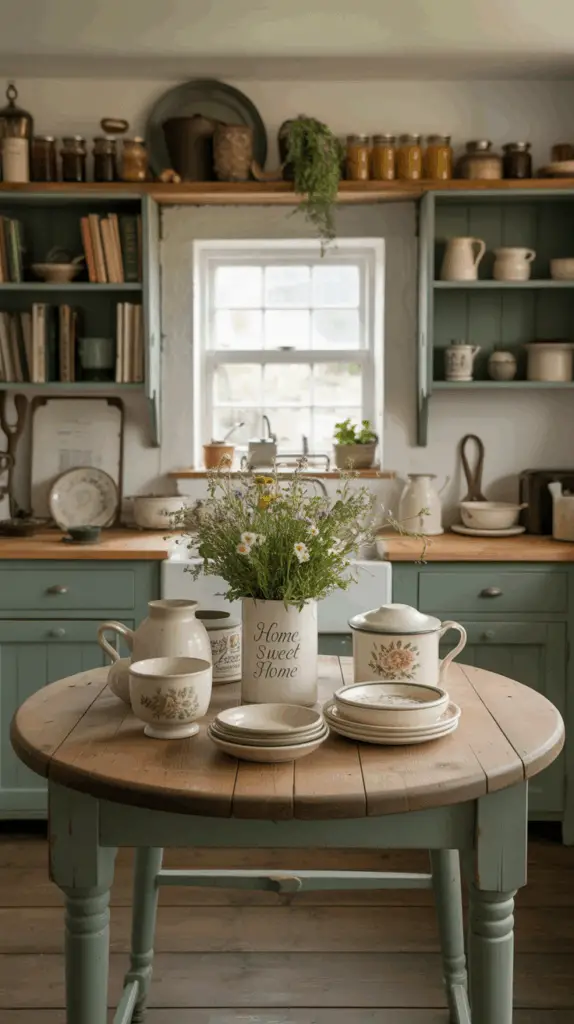
Blending Old and New for Functional Beauty
One of the most appealing things about unfitted kitchens is the opportunity to blend eras. Cottage homeowners often love the nostalgia of old-fashioned details, but daily life demands some modern conveniences. The art lies in marrying these two worlds seamlessly.
For example, you might install a sleek under-counter fridge behind a vintage cabinet door, or pair a weathered butler sink with an elegant brass tap. The key is in surface finishes, hardware, and color. Opt for muted tones—sage green, pale cream, or deep navy—and materials like wood, marble, or stone that patinate over time.
Open shelving is another clever way to mix eras. You can display antique enamelware beside modern glass jars or a vintage toaster alongside contemporary cookware. This encourages daily use of beautiful things rather than keeping them locked behind closed doors.
Aesthetically, creating cohesion matters. While each piece might be unique, tying everything together with a consistent palette or repeating material—like reclaimed wood or aged brass—prevents the kitchen from feeling disjointed.
Table: Mixing Old and New in Cottage Kitchens
| Design Element | Vintage Option | Modern Complement |
| Sink | Belfast or butler sink | Brass or matte black tapware |
| Storage | Reclaimed pantry cupboard | Soft-close drawer inserts |
| Surface | Aged wood countertop | Quartz or soapstone island |
| Lighting | Industrial pendant lights | LED under-shelf lighting |
| Appliances | Retro-style cooker | Hidden dishwasher panel |
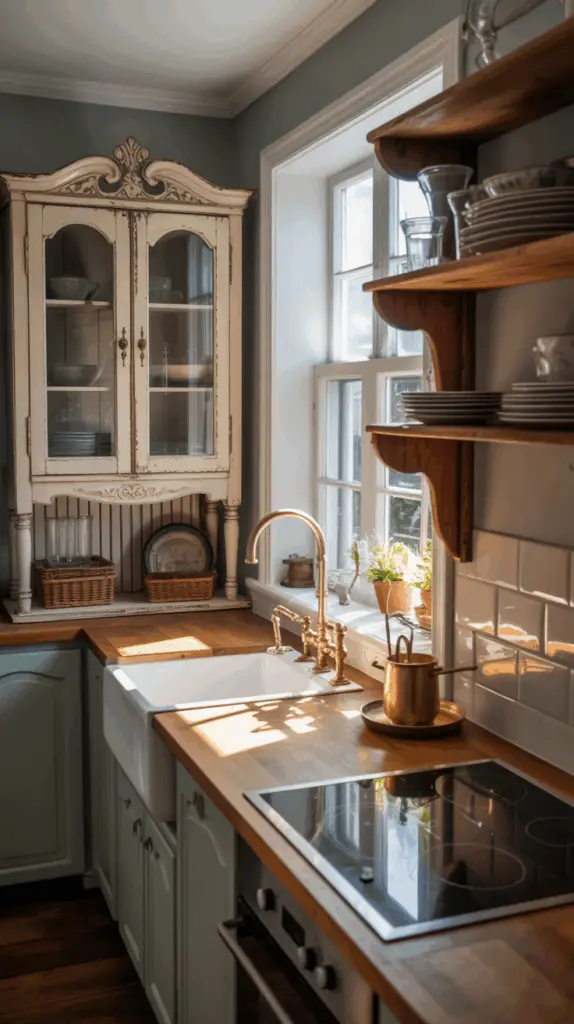
Creative Storage Solutions Without Built-Ins
Storage is often a challenge in any kitchen, but it’s especially true when you forgo fitted cabinets. The solution? Get creative. In unfitted kitchens, your storage can be beautiful and functional at the same time.
Use vintage armoires or dressers as larders or crockery cupboards. Repurpose wooden crates as pull-out drawers beneath worktables. Hang pots from ceiling racks, or display glass jars filled with dry goods on open shelving. Each choice becomes a visual feature as much as it is a practical one.
Even if your kitchen is small, clever zoning helps make everything work. One corner could house a free-standing butcher block for prep, another could have an old table acting as both island and dining spot. Hooks on walls and inside doors add storage without bulk.
Best of all, this flexibility allows you to change things as your life evolves. A cupboard might become a wine rack. A bench might gain hidden compartments. Unfitted kitchens grow with you—and that’s part of their charm.
Table: Creative Storage Ideas for Unfitted Cottage Kitchens
| Storage Type | Practical Use |
| Vintage dresser | Store crockery, linens, or pantry goods |
| Open shelves | Display dishes, dry goods, or glassware |
| Butcher block island | Prep station with drawers underneath |
| Hanging rails/hooks | Store pots, pans, utensils |
| Repurposed crates | Under-table or open-shelf drawers |
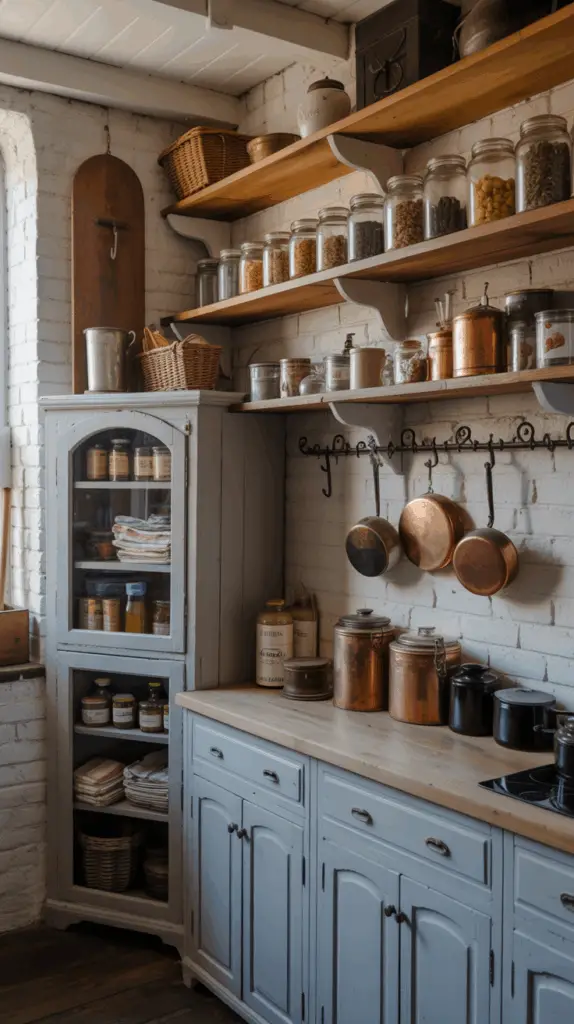
Choosing the Perfect Mix of Freestanding Furniture
Furniture is the heart of the unfitted kitchen. Without uniform cabinetry, each piece needs to pull its weight both functionally and aesthetically. But that doesn’t mean everything must match—far from it. The magic lies in curating a harmonious variety.
Start with the essentials: a worktable, a storage piece (like a dresser or armoire), and a prep surface such as a butcher block or movable island. Opt for materials that speak to the cottage look—painted wood, natural finishes, or distressed textures. Each item should feel like it has a story.
Balance is key. If your table is chunky oak, pair it with something visually lighter like a wire shelf or delicate chair. If your dresser is ornate, choose simple stools to avoid clutter. Use height differences to create rhythm and keep the room feeling open.
You can also customize modern furniture to suit your style. Sand down a new piece and repaint it in a chalky pastel. Swap knobs for antique brass handles. Mix painted finishes with natural wood to echo the soft, lived-in palette of cottage homes.
Furniture Breakdown for an Unfitted Kitchen
| Furniture Piece | Function | Cottage Style Tip |
| Freestanding pantry | Dry goods storage | Opt for distressed paint or leaded glass |
| Worktable or island | Prep and dining | Use reclaimed timber or add caster wheels |
| Hutch or dresser | Display dishes and serveware | Choose one with open shelving or glass doors |
| Bench or banquette | Seating with hidden storage | Add cozy cushions in floral fabrics |
| Mobile butcher block | Extra prep with flexibility | Look for one with hooks or towel rails |
Designing Around Architectural Quirks
Cottage homes are rarely cookie-cutter in shape. You’ll find sloped ceilings, awkward nooks, shallow alcoves, and wonky floors. Instead of fighting these features, unfitted kitchens embrace them, turning oddities into opportunities.
Tuck a narrow sideboard into a low-ceilinged corner. Use a built-up platform to level an uneven floor beneath a sink. A former fireplace alcove can become a snug pantry nook. These are the kinds of solutions that lend a cottage kitchen both functionality and poetry.
Use light strategically—mirrors, glass-fronted furniture, or reflective tiles help open up cramped areas. And don’t be afraid to let beams, brick, or plaster remain exposed—they’re part of the cottage charm.
Sometimes the best design decision is restraint. Leave space around furniture to let the room breathe. Avoid overcrowding. It’s better to have fewer pieces that shine than to cram in too much.
Table: Making the Most of Awkward Cottage Spaces
| Architectural Feature | Design Solution |
| Sloped ceiling | Low dressers or benches |
| Uneven floors | Adjustable furniture feet or custom plinths |
| Small alcoves | Built-in shelves or spice racks |
| Old hearths | Coffee station or prep nook |
| Deep windowsills | Herb gardens or display of ceramics |
Color, Texture, and Materials That Add Cottage Soul
A cozy unfitted kitchen depends as much on texture and color as it does on furniture. Soft, muted shades—think warm white, dove grey, sage green—set the stage for calm. Accent with natural wood, antique metals, and soft linen or floral textiles.
Texture is essential in a cottage kitchen. Combine rough and smooth: a stone floor with a waxed pine table; a polished marble countertop with beadboard paneling. Layers create depth, interest, and that irresistible lived-in feel.
Natural materials age gracefully, adding patina and story to the room. Imperfection isn’t a flaw—it’s a feature. That chip in the enamel bread bin or dent in the worktop tells a tale. Embrace it.
Soft lighting—like sconces, fairy lights, or candles—enhances the cozy factor. Avoid harsh overhead light unless it’s dimmable. The goal is to create a room that glows.
Table: Cottage Kitchen Material Palette
| Element | Suggested Material |
| Walls | Limewash, beadboard, or soft matte paint |
| Worktops | Wood, soapstone, or aged marble |
| Flooring | Flagstone, terracotta, or painted wood |
| Hardware | Aged brass, wrought iron, or ceramic knobs |
| Textiles | Linen, ticking stripe, floral cotton |
Conclusion: Embracing the Unfitted Lifestyle
Designing an unfitted kitchen is more than a stylistic choice—it’s a mindset. It celebrates imperfection, personality, and the passage of time. In a cozy cottage home, where charm and character matter most, this approach helps create a kitchen that feels both grounding and inspiring.
By thoughtfully curating freestanding furniture, working with architectural quirks, and blending old with new, you craft a space that evolves with you. It’s not about perfection—it’s about creating a room where stories are made, meals are shared, and the soul of the home shines through.
An unfitted cottage kitchen invites you to slow down, savor your space, and find beauty in the everyday.
